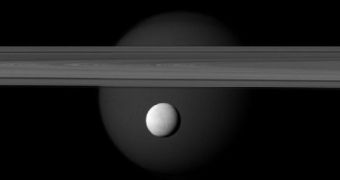The NASA Cassini spacecraft – which has been analyzing Saturn, its ring system and its moon since July 1, 2004 – snapped this amazing view of the icy moon Enceladus on March 12, 2012. The object appears very bright here, since it's bathed in sunlight.
This image has a relatively low resolution, of 4 miles (6 kilometers) per pixel, but it was collected from a distance of around 600,000 miles (1 million kilometers), so that can be excused. The object behind Enceladus is not Saturn, but Titan, the gas giant's largest moon.
With this image, Cassini reveals the extreme difference between the two objects, some of the most interesting ever to develop within the solar system. While Enceladus is only 313 miles (504 kilometers) across, Titan is around 3,200 miles (5,150 kilometers) in diameter.
The spacecraft collected this view of both moons as it was flying above the plane of Saturn's rings. Cassini is currently getting ready to move to a polar orbit around the planet, which means that it will have only a handful of rendezvous with other moons until 2015.

 14 DAY TRIAL //
14 DAY TRIAL //